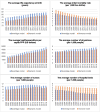Association between healthcare resources, healthcare systems, and population health in European countries
- PMID: 40390026
- PMCID: PMC12087073
- DOI: 10.1186/s12913-024-11743-0
Association between healthcare resources, healthcare systems, and population health in European countries
Abstract
Background: Recently, the demand for care has risen, while in contrast, healthcare resources remain limited. These resources include health expenditure, the number of physicians, nurses, and hospital beds. Many studies have revealed that healthcare resources are one of the most critical factors contributing to a population's health status. The healthcare system plays a key role in transforming these resources into health outcomes, which are widely used as indicators to measure population health and the performance of healthcare systems. Previous work has primarily investigated the relationship between health expenditure or the number of doctors and population health. However, the association between healthcare resources as a whole has yet to be widely examined.
Methods: This study utilized multilevel regression analysis to explore the association between healthcare resources, healthcare systems, and population health outcomes across 25 European countries. The healthcare systems in these countries are primarily categorized into two types: Beveridge-type and Bismarck-type. In addition to regression analysis, descriptive statistics were used to analyze the allocation patterns of healthcare resources. Welch's t-test was employed to compare the performance metrics of the Beveridge-type and Bismarck-type healthcare systems, providing a statistical basis for understanding differences in their effectiveness.
Results: The regression analysis revealed positive correlations between health expenditure per capita, the number of physicians, and nurses, and life expectancy at birth, while the number of hospital beds showed a negative correlation. Conversely, infant mortality was negatively correlated with health expenditure per capita and the number of physicians and nurses, and positively correlated with the number of hospital beds. The models did not find statistical significance in the effects of healthcare system type (Beveridge-type or Bismarck-type) on life expectancy at birth or infant mortality rates. Additionally, Welch's t-test indicated that the Beveridge-type healthcare system generally showed better performance outcomes compared to the Bismarck-type system.
Conclusions: The findings indicate that higher allocations of certain healthcare resources, such as hospital beds, are associated with poorer health outcomes, which suggests potential inefficiencies in resource utilization. Observations also show that countries using the same healthcare systems tend to have similar patterns of resource allocation, which may influence the performance of these systems. Policymakers should consider these associations when planning resource allocation and when selecting or modifying healthcare system models in their countries.
Keywords: Health outcomes; Healthcare resources; Healthcare system performance; Multilevel regression model; Population health; Resource allocation.
© 2024. The Author(s).
Conflict of interest statement
Declarations. Ethics approval and consent to participate: Not applicable. Consent for publication: Not applicable. Competing interests: The author declares no competing interests.
Figures
Similar articles
-
Changes in the Number of Physicians and Hospital Bed Capacity in Europe.Value Health Reg Issues. 2022 Nov;32:102-108. doi: 10.1016/j.vhri.2022.07.003. Epub 2022 Sep 25. Value Health Reg Issues. 2022. PMID: 36170790
-
Bismarck or Beveridge: a beauty contest between dinosaurs.BMC Health Serv Res. 2007 Jun 26;7:94. doi: 10.1186/1472-6963-7-94. BMC Health Serv Res. 2007. PMID: 17594476 Free PMC article.
-
Identifying determinants of spatial agglomeration of healthcare resources by using spatial econometric methods: a longitudinal study in China.Front Public Health. 2024 May 28;12:1351849. doi: 10.3389/fpubh.2024.1351849. eCollection 2024. Front Public Health. 2024. PMID: 38864022 Free PMC article.
-
Impact of the Covid pandemic on timely cancer diagnosis across European healthcare settings: a scoping review.Ann Ig. 2024 Mar-Apr;36(2):194-214. doi: 10.7416/ai.2024.2596. Epub 2024 Jan 18. Ann Ig. 2024. PMID: 38240184
-
An overview of different health indicators used in the European Health Systems.J Prev Med Hyg. 2017 Jun;58(2):E114-E120. J Prev Med Hyg. 2017. PMID: 28900351 Free PMC article. Review.
References
-
- United Nations, Department of Economic and Social Affairs, Population Division. World Population Prospects 2019: Highlights (ST/ESA/SER.A/423). 2019.
-
- Worldbank. Population ages 65 and above, total. 2020. Available from: https://data.worldbank.org/indicator/SP.POP.65UP.TO.
-
- Statista. Statista. 2023. Proportion of selected age groups of world population and in regions in 2023. Available from: https://www.statista.com/statistics/265759/world-population-by-age-and-r....
-
- American Hospital Association. TrendWatch Chartbook 2018. Washington: American Hospital Association; 2018 p. 150. Available from: https://www.aha.org.
-
- Pallipedia. Health resources. Available from: https://pallipedia.org/health-resources/.
MeSH terms
LinkOut - more resources
Full Text Sources
Medical



